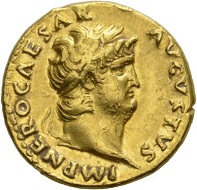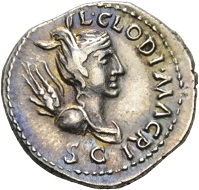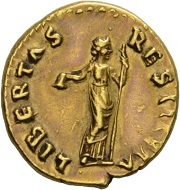Nine months and 13 days: the reign of Galba
Surviving under emperors such as Caligula or Nero was an art in itself, especially if you belonged to the Roman upper class. They tended to consider prominent members of the Senate their rivals, and thus to eliminate them. Anyone who did not master the art of survival died. Galba mastered it perfectly. And he survived. He had turned already 73 – a venerable age in the eyes of the Romans – when the governor of the province of Gallia Lugdunensis contacted him in the winter of 67/68. This governor had put himself at the forefront of all those who no longer wanted to fund Nero’s extravagances.
Nero. Aureus, Rome, 66/7. Rv. SALVS Salus enthroned l., holding patera in extended r. hand. RIC 66. Insignificant marks on the rim. Almost extremely fine. Estimate: 2.500 CHF. From the Galba Collection, Hess-Divo sale 333 (November 30, 2017), No. 85.
Nero had tried to finance its incredibly expensive infrastructure projects by increasing the taxes for the provinces. We still have a testimony to how much money the emperor actually spent: Aurei featuring the portrait of Nero are much more common when compared against those of other emperors.
Gaius Iulius Vindex, governor of Gallia Lugdunensis, came from the former ruling elite of Aquitaine. This may be the reason why he was so concerned about the well-being of his province. But even if he could count on the support of the Gauls, he knew exactly that the Roman Senate would not be willing to cooperate with him. He needed an ally, one which every Roman respected and appreciated. And so he got in touch with Servius Sulpicius Galba, governor of the neighboring province of Hispania Tarraconensis.
Galba, 68-69. Sestertius, September 68. Rv. AVGVSTA / SC Livia enthroned l., holding scepter and patera. RIC 336. Tiber patina. Very fine. Estimate: 1,000 CHF. From the Galba Collection, Hess-Divo sale 333 (November 30, 2017), No. 122.
He was presumed the last representative of the great old families of the Roman Republic. His father had already been consul. His mother traced her history back to the family of Quintus Lutatius Catulus who was known as an important politician already at the time of Nero. But much more important was the fact that Empress Livia had supported Galba personally. Thus Galba associated with Augustus, the divine founder of the Julio-Claudian imperial dynasty. A valuable asset in the bargain, and a fact which Galba never grew tired of emphasizing in his coin imagery after his rise to power.
Galba, 68-69. Denarius, Tarraco, April-late 68. GALBA IMP Galba riding l., r. hand raised to address. Rv. HISPANIA Bust of Hispania l., two javelins over l. shoulder, two corn-ears in front, round shield below neck truncation. RIC 2. Toned. Very fine+. Estimate: 500 CHF. From the Galba Collection, Hess-Divo sale 333 (November 30, 2017), No. 95.
Galba had administered his province of Hispania Citerior, which is also known as Hispania Taraconensis after its capital Tarraco (= Tarragona), since 60 AD. It was a clear vote of confidence that Nero had bestowed this position on him, because there were important military units concentrated in this province of which Galba was supreme commander. Of course the emperor knew that. And when the Imperial court learned about the rebellion of Vindex in Rome, the courtiers immediately assumed that Galba could become a threat. A threat that should be eliminated by murder as quickly as possible.
Galba, 68-70. Denarius, Spain. BON EVENT Head of Bonus Eventus r. Rv. ROM – RENASC Roma standing r., holding Victoriola in extended r., who crowns her. RIC 9. Extremely fine. Estimate: 1,500 CHF. From the Galba Collection, Hess-Divo sale 333 (November 30, 2017), No. 88.
The murder failed. And what was even worse, it made clear to Galba that his cautious tactics would not protect him from another assassination attempt by Nero. He only had one option: Take the bull by the horns and start a rebellion. But Galba stayed true to himself and acted with caution again: On April 2, 68, he stepped in front of the army on the forum of Cartagena. He had surrounded himself with the statues of all the victims of Nero and was accompanied by a young man Nero had sent into exile. Galba chose his words carefully. He didn’t shout defiance. And yet the army did what it was expected to do: It proclaimed Galba emperor.
Coins like our example fit in with this early stage of Galba’s reign. It shows the Bonus Eventus, the deity who granted good opportunities that should be embraced. And Roma Renascens, the resurrection of Rome, goes extremely well with a rebellion targeting the degenerate rule of someone like Nero. Galba, as was the underlying message, was to reawake ancient Rome though his genuinely Roman virtues.
Galba, 68-69. Aureus, Tarraco(?), April-late 68. GALBA – IMP Laureate head r. Rv. ROMA – VICTRIX Roma standing l., with spear and branch. RIC 44var. Unpublished variant(?) Very fine. Estimate: 10,000 CHF. From the Galba Collection, Hess-Divo sale 333 (November 30, 2017), No. 101.
Galba remained cautious, as can be inferred, for example, from the titulature he chose for his coins. He could not avoid striking his own denarii and aurei, since as the new imperator he was responsible for paying the troops. But he was able to design the coins in such a way that no legal charges could have been pressed against him. Galba was imperator. He had received this honor already from Claudius for his service in Africa. However, Galba ostentatiously avoided the title of Caesar or even Augustus – until Nero disavowed himself by his own political inability so much that the Senate dismissed him on June 9, 68, and sentenced him to death. Galba was appointed his successor.
Galba, 68-69. Sestertius, Rome, June-August 68. SER GALBA IMP – CAES AVG TR P Draped bust with wreath of oak leaves r. Rv. ROMA / S-C Roma sitting on cuirass l. RIC 247. Red-brown patina. High relief. Very fine+ / Very fine. Estimate: 2,500 CHF. From the Galba Collection, Hess-Divo sale 333 (November 30, 2017), No. 105.
In mid-June of 68, Galba was informed of having been appointed emperor. He changed the legends right away, and called himself Caesar and Augustus from then on. He moved to Rome, which became the focal point of his actions for the few months remaining. He had a relatively high number of high-quality sestertii minted there. Stylistically superb high-relief portraits such as this one are typical of his reign. The imagery on the reverse often refers to Rome and addresses the concerns of the Roman people.
Galba, 68-69. Sestertius, Rome, August-September 68. Rv. LIBERTAS – PVBLICA / S-C Libertas standing l., with pileus and scepter. RIC 309. Light brown toning. Very fine+ / Very fine. Estimate: 1,250 CHF. From the Galba Collection, Hess-Divo sale 333 (November 30, 2017), No. 117.
The goddess Roma is just as often portrayed as the civic crown made of oak leaves, which was awarded to the ones who had saved the life of a Roman citizen. Augustus had already liked to depict this honor on his coins, to recall the fact that he had ended the civil war. We find references to the grain supply of the city, and to concord. The depiction of Libertas holding the pileus in her hand, the felt cap that was put on the head of every freed slave in Rome, is particularly informative. Galba alludes to the fact that he liberated the Roman people from the tyranny of Nero.
Galba, 68-69. Aureus, Rome, July 68-January 69. Rv. SALVS GEN – HVMANI Salus standing l., sacrificing with patera over burning altar, holding rudder in l. arm. RIC 147. Extremely fine. Estimate: 10,000 CHF. From the Galba Collection, Hess-Divo sale 333 (November 30, 2017), No. 135.
An exception are the coins that bear the inscription Salus Generis Humani (= salvation of the human race). This might refer to a hallowed battle cry directed against Nero, which the Western legions used during battle.
Clodius Macer. Denarius, North Africa, 68. L CLODI MACRI / SC Bust of Victoria r. Rv. LIB AVG Legionary eagle between two standards, below LEG – III RIC 15. One of the great rarities of Roman coinage: Less than 10 specimens of this type are known to exist. Extremely fine. Estimate: 25,000 CHF. From the Galba Collection, Hess-Divo sale 333 (November 30, 2017), No. 87.
In the same month that Galba positioned himself in Spain as an opponent to Nero, Clodius Macer, the imperial legate of the province of Africa, started another rebellion against Nero. We do not know much about it; it seems safe to assume, however, that Galba did not co-operate with Macer. On the contrary, Macer’s assassination in October 68 is said to have taken place on Galba’s orders.
All of Macer’s coins rank among the great rarities of Roman numismatics. Apparently, he struck an extremely low number of coins, all denarii. Thus, relatively few dies have come down to us.
This type is known from less than 10 specimens only. It is dedicated to Legio III Augusta. This was the legion stationed in Numidia, which supported Macer during his uprising.
Galba, 68-69. Aureus, July 68-January 69. Rv. Galba riding r., wearing military dress, r. hand raised to address. RIC 227. Almost extremely fine. Estimate: 5,000 CHF. From the Montagu Collection. From the Galba Collection, Hess-Divo sale 333 (November 30, 2017), No. 151.
Even if Galba presents himself as the ideal image of a soldiers’ commander on this aureus – in the gesture of addressing, in full military dress, on horseback – his lack of empathy towards the legionaries was to become his doom. Yet Galba was actually ideally equipped to win the praise of the soldiers. He had been in the field for many years, commanding legions. But his reputation harked back more on his insisting on discipline than his generosity. So Galba forgot to grant a reward where a reward would have been appropriate. Furthermore, many deemed the punishments he imposed unreasonably harsh.
Instead of concentrating on his army, Galba concentrated on balancing the state coffers. He tried to recover the 2.2 billion sestertii Nero had given away as gifts. The Oracle of Delphi, for example, had to return the 40,000 sestertii it had been given by Nero. With actions like these, certainly no one makes any new friends!
Vitellius, 69. Aureus, July 68-January 69. Rv. LIBERTAS – RESTITVTA Libertas standing r., holding scepter and pileus. RIC 104. Almost extremely fine. Estimate: 10,000 CHF. From the Galba Collection, Hess-Divo sale 333 (November 30, 2017), No. 163.
The tide was turning for Galba on January 1, 69, when all the legions were requested to renew the oath on the emperor in a solemn ceremony. The Roman army on the Rhine refused. The legionaries were upset that Galba had not rewarded them adequately for their support during the rebellion. Aulus Vitellius, commander of the troops in Germania Inferior, took advantage of the situation and had himself proclaimed emperor in Cologne on January 2, 69. He pulled out major parts of the troops, which should have protected the province against the Batavians, in order to march with them to Rome and claim the Imperial dignity.
Otho, 69. Aureus. Rv. SECVR-I-TAS PR Securitas standing l., holding scepter and wreath. RIC 7. Very fine. Estimate: 5,000 CHF. From the Galba Collection, Hess-Divo sale 333 (November 30, 2017), No. 154.
As soon as this information reached Rome, it was clear that Galba had to name a successor. Being himself busy in Rome, he needed a loyal deputy to confront Vitellius. Many had high hopes. They were disappointed, though. Galba did not choose one of his supporters but a member of an old Republican family that is known so well to all connoisseurs of Roman Republican coinage: Lucius Calpurnius Piso Frugi Licinianus.
One of the disappointed took action. Marcus Salvius Otho gathered all those around him who were equally fed up with Galba and his frugal, old-fashioned way to rule. He received the support of the Praetorians, who expected him to gift them with larger sums of money. Having been punished too severely by Galba, a legion of naval soldiers also joined them. At the bottom line, the end was foreseeable.
The strength of the enemy troops took Galba by surprise. He tried to take up the fight. A bad decision. Galba, who had been carried into battle in a litter, was killed by superior numbers on the Roman forum.
His successor, Otho, ruled for three months only. He was killed in the fight against Vitellius, who made it to December 20 or 21, when the troops of Vespasian conquered Rome.
That put an end to the eventful year AD 69. It went down in Roman history as the Year of the Four Emperors.
You can order the catalog of Auction 333 from Hess-Divo at +41 (0)44 225 40 90 or via e-mail.
The catalog can of course also be viewed online, at Sixbid.
































